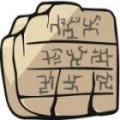
Worksheets and No Prep Teaching Resources
Reading Comprehension Worksheets
History of Books and Writing

History of Books and Writing
 Worksheets and No Prep Teaching Resources Reading Comprehension Worksheets History of Books and Writing |
 History of Books and Writing |
| edHelper's suggested reading level: | grades 9 to 12 | |
| Flesch-Kincaid grade level: | 8.84 |
|
The Phoenicians' Purple Passion
By Colleen Messina |

|
 1 The seafaring Phoenicians of the twelfth century B.C. had a passion for purple. Who would have thought that this purple passion would lead to the world's first true alphabet? The Phoenicians, who lived in what is now Syria, were a group of seamen and their families. They were a confederation of seafarers, not a nation of people bound together by a single culture or system of rule. However, they bravely sailed farther than any other ancient people to trade in wood, precious metals, and wine. They also sold their own special purple dye. In fact, they had a monopoly on purple!
1 The seafaring Phoenicians of the twelfth century B.C. had a passion for purple. Who would have thought that this purple passion would lead to the world's first true alphabet? The Phoenicians, who lived in what is now Syria, were a group of seamen and their families. They were a confederation of seafarers, not a nation of people bound together by a single culture or system of rule. However, they bravely sailed farther than any other ancient people to trade in wood, precious metals, and wine. They also sold their own special purple dye. In fact, they had a monopoly on purple! |
Create Weekly Reading Books
Prepare for an entire week at once! |
| Leave your feedback on The Phoenicians' Purple Passion (use this link if you found an error in the story) |
 |
History of Books and Writing
|
 |
High School Reading Comprehensions and High School Reading Lessons
|
 |
Social Studies
|